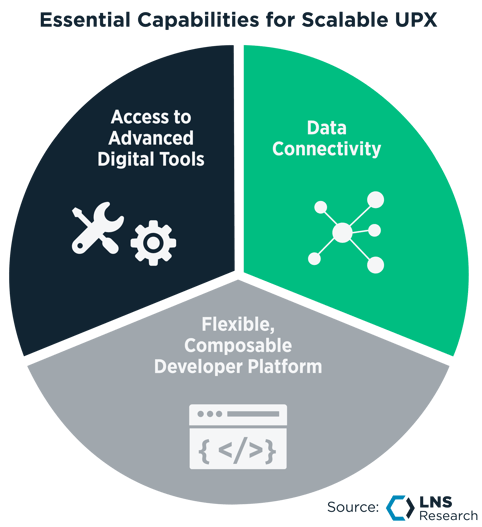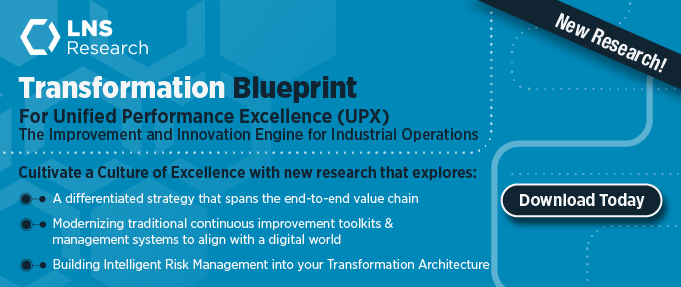While there is not a well-understood software category dedicated to Digitizing Performance Excellence, there are a variety of software vendors with offerings moving into this category, and I discuss a few below.
Intelligent Risk Management (IRM), however, is another beast entirely from the Digital Performance Excellence engine. Some risk management activities are presently managed in various industrial applications, such as Enterprise Quality Management Software (EQMS) for product and customer risk associated with product quality to worker safety risks in Environment, Health, and Safety (EHS) software. Even so, these risk management activities are tactical, small "r" risk management. Big "R" Risk Management is focused on the strategic operation of manufacturing to support the company’s value proposition. The approach to risk thinking is similar, but the scope is more expansive, and as a result, the scalable applications for IRM at the organizational level tend to be those Industrial Application Platforms mentioned below, where a unique set of risk frameworks can be built and connected to real-time data sources, bringing machine learning to bear on this rapidly changing data to surface changing risks for development of strategy and action. The digital improvement engine that is Unified Performance Excellence (UPX) can be built in a variety of places in the operational architecture and still be effective and scalable.
In our recent research on UPX, LNS Research found Enterprise Quality Management Software is the platform of convenience (Figure 1), with 34% of respondents indicating their UPX is built on an EQMS. If chosen wisely, this might fit the need for a scalable platform; however, most EQMS do not have the necessary capabilities to meet the requirements. The good news is that several software categories could serve well as a platform for UPX, such as:
-
-
-
Enterprise Quality Management Software: There are a handful of EQMS offerings that could serve as a platform on which to build UPX. Some of these include MasterControl, AlisQI, ETQ, and Veeva Systems.
-
Connected Frontline Workforce Applications: A few meet the need for the execution and mid-management layers of UPX. That is, getting insight to the shop floor worker, making it actionable, and driving speed of execution that brings the worker into the mix, as well as supervisory activities like shift handoffs, skill development, and some process management. Some of these are L2L, Augmentir, and QADRedzone.
%20720x783-1.png?width=518&height=563&name=2023%20Enterprise%20Quality%20Management%20Software%20(EQMS)%20720x783-1.png)
Figure 1: EQMS is the Platform of Convenience
-
Advanced Industrial Analytics Applications: Some analytics software applications bridge over to insight delivery to the frontline worker. We see two levels of play for Analytics in UPX.
Some analytics packages with these capabilities include Oden Technologies and Augury, which direct insights to the shop floor worker and process engineering persona, and Quartic.ai, which targets the process engineer persona for their insights.
-
Various Other Applications: Several large software vendors have packaged sets of applications focused on improvement, such as:
-
PTC’s Digital Performance Management package
-
Dassault Systèmes’ Lean Team Player package in their Delmia Suite
-
Schneider Electric’s recently launched Ecostruxure Plant Lean Management
-
Industrial Data Platforms/Industrial Application Platforms: These software categories have the three essential elements for building a successful, scalable Digitized Performance Excellence Some platforms in this category include Industrial Data Platforms such as TwinThread, Cognite, and SightMachine, as well as Industrial Application Platforms such as Siemens and Tulip.
-
Cloud Providers: Industrial Cloud providers have an attractive niche for some to build their DPX. Microsoft has developed its PowerApps set of workflow design and connectivity solution builder/development environment that is sometimes an attractive, low-cost option. However, this approach will inevitably take much longer to build on and will have fewer choices of possible connectivity than an Industrial Data Platform or Industrial Applications Platform.
The bottom line is that there are several places to consider when building your digital approach to UPX. Regardless of where you build it, any platform for UPX must have three core capabilities (Figure 2).

Figure 2: Capabilities to Leverage Best Practices in UPX
-
-
-
Robust data connectivity across the enterprise and into the shop floor processes. This capability is essential to feed Intelligent Risk Management and the Execution Engine with the real-time data needed to leverage advanced digital tools - the next core capability.
-
Access to or embedded advanced digital tools: UPX brings advanced digital tools such as Artificial Intelligence, Machine Learning, Digital Twins, and Advanced Industrial Analytics into the mix to;
-
-
Speed time to insights and results, a key contributor to loss of momentum, which is a characteristic of policy & procedure-based traditional approaches.
-
Add intelligence to the risk management function, surfacing changing risks in near-real-time and allowing critical time to build mitigation and prevention plans against the realization of threats to operational agility, flexibility & resiliency.
-
Flexible, composable citizen-developer-enabled design platform: The overwhelming majority of industrial companies reported leveraging internal expert resources to build the company-specific approach to UPX.
Recommendations for manufacturers struggling with momentum in Performance Excellence
-
-
-
Build with what you have, scale with what you need. Building trial versions of tools and processes on apps you have already paid for, such as an EQMS, makes sense from a piloting and proving standpoint. However, the platform must have three essential elements for a scalable solution: access to data sources, advanced digital tools, and a flexible application design platform.
-
Leverage internal experts to build it. A significant investment in time and development goes into creating the internal expert practitioner group. To speed development and, at the same time, build a branded program, leverage these internal expert resources to design the tools and processes on the chosen platform.
-
Empower laggards to “leapfrog” using digital approaches. Once refined and ready to scale, the digital approach to Performance Excellence can serve as an accelerator for those parts of the company that are lagging behind in developing the culture of excellence.
